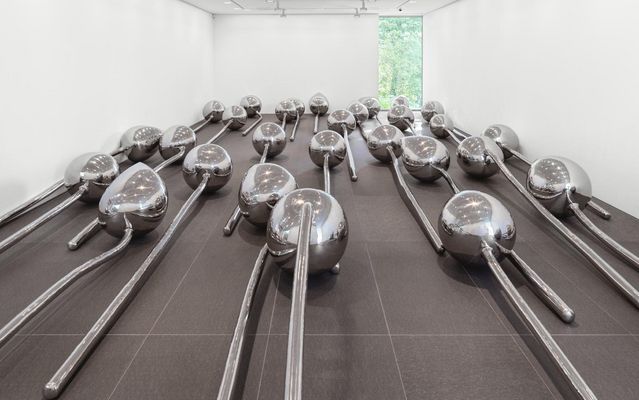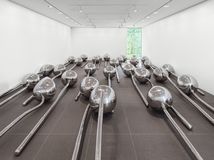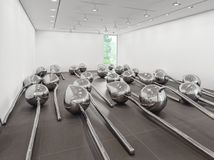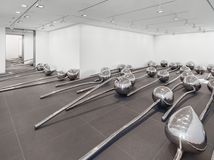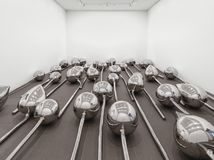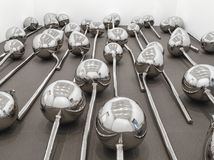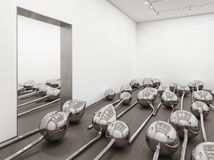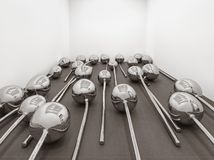LET ONE HUNDRED FLOWERS BLOOM
Vital’s complex oeuvre is largely based upon biographical experiences and cultural sensitivity, often presenting a collision of the deeply personal and of topical realities. When considering the context of Vital’s work there is, on the one hand, his childhood, spent in the mountains and isolated Engadin valley, Switzerland. And, on the other hand, the nomadic existence Vital has adopted since his late teens – leading him to the peripheries of the world. Vital’s choice of travel destinations is full of juxtapositions: moving from the freezing mountains of winter and intense greenery summer in the Engadin, to the burning heat of the desert in Agadez, Niger (where he has had a home for over ten years). And within China itself, where Vital has been travelling to for the last five years, there is the smog and the chaos of Beijing: grey, industrial and sprawling; in contrast with the sublime, unspoilt nature of the landscapes of Southern China. Vital’s inexhaustible appetite for travel, and exposure to different people and places, has contributed richly to his work in many senses: material, thematic and collaborative. This can be observed in particular periods throughout Vital’s career: he has spent time with third-generation Venetian glass blowers in Murano, Tuareg silversmiths in Niger, papermakers in Bhutan. Currently Vital’s life revolves, according to his artistic projects, around Sent (Engadin, Switzerland), Patagonia, Agadez (Niger) and Beijing.
Since 2008 Vital has spent four months per year in China, primarily working in his studio in the Caochangdi district of Beijing. Aside from residing in Beijing, Vital travels extensively around China, and South-East Asia. He has found many wildly different landscapes, people, food, and dialects. He has immersed himself into all the differences that can be found within one country. He has searched for marble stones in Southern China, and explored potential landscapes on which to build a “House to Watch the Sunset”. He has negotiated with farmers over the rental of land, and learnt about Chinese property laws and regulations. He has painted his Chinese assistants in the studio, learnt basic Chinese, found steel-workers and a foundry, and a woodworker in another part of town. He has found new types of plaster and plexiglas the consistency of which does not exist in Europe. He has commissioned a 3-meter long traditional calligraphy brush to be made in the South of China. Through these journeys, negotiations and collaborations Vital reveals to us the richness of China, in ways that are surprising and enigmatic, yet concrete too.
On the outskirts of Beijing, Vital discovered a stainless steel foundry, with exceptionally skilled and creative craftsmen. It is here that the installation “Let One Hundred Flowers Bloom” (consisting of 100 stainless steel lotus flowers, each circa three meters long) was produced in 2007–2008. The title of this installation, “Let One Hundred Flowers Bloom”, is simultaneously poetic – in its Romantic visual language – and absolute – in its authoritarian command. The title refers to the slogan for a short-lived propaganda campaign Mao Zedong enforced in 1956. The stainless steel is crafted by hand, rather than cast; the latter is now the norm in Europe. Welding together, chasing, and hand-polishing the steel is a complicated, arduous and lengthy process. Indeed, the technical process is an integral part of our understanding of the work, which results in a smoothly polished surface that is highly reflective. Thus, the way the stainless pieces are exhibited – and their surroundings – dramatically change one’s conception of the work. Fragmented colours and forms are reflected in the bulbous lotus heads and their pointed ends, as well as in the long, graceful stems. Vital has produced several other sculptures in stainless steel in Beijing, such as: a Moon, complete with variously-sized craters: the 7 meter tall Tongue; Pelvis – representing the form of a 3.5 meter tall upright pelvis-bone. It is interesting to note that all Vital’s stainless steel pieces are representations of organic forms. This brings to the fore the juxtaposition between the natural world and man-made industrial technique and material.
The lotus has become a recurring theme in Vital’s work since he first visited China in 2007. Indeed, one can compare this to how the tongue became iconographic in Vital’s work after a chance trip to the butcher in Lucca, Italy in 1985, where he bought cow’s tongues and cast them in bronze, before making them in white marble, plaster, silver and stainless steel. Similarly, after Vital’s first trip to Africa, he introduced the camel into his artistic vocabulary, using materials from plaster, to aluminium, to silver and both abstract and figurative representation. In turn, Vital has presented his audience with lotuses made from plaster, fiberglass with white varnish. In 2010, he produced a double-headed lotus, which exists as and imperfect reflection of itself. The lotuses have formerly been presented alone or in small groups, both upright and as floor-pieces. Thus we can see the artist’s process – both mental and physical – in his interpretation of the lotus, introducing it as a new, iconic, form in his oeuvre.
As in all of Vital’s work, there are many different ways to approach “Let One Hundred Flowers Bloom”, from the philosophical to the formal. One aspect of the work that illustrates this richness of interpretation is the significance of Vital’s use of closed flower buds rather than open ones. This choice, which is certainly not accidental, conveys a sense of reservation, of oppression and isolation. The flowers lie side by side but appear as self-contained units, close in proximity but distanced by their self-enclosed form. The viewer might await a moment when these buds will burst, defying their bound forms. This sense of potential movement, an explosion, lends tension and dynamism to the enigmatic installation. Another aspect of the installation which is driven as much by form as by human memory and association is the way that the flowers are cut and strewn across the floor, suggesting violence, mutilation, displacement.
“Let One Hundred Flowers Bloom” presents its audience with a historical context, and space for thinking about today’s world. Patterns of abuse of authority and power, repression of people, and indifference towards human rights can be considered. The installation plays with the idea of microcosm and macrocosm. One hundred individual lotuses find themselves placed together to create this huge mass; the effect appears metaphorical and politically fraught.
The magnitude of the installation of one hundred lotuses strewn across the floor has an overwhelming presence, that is simultaneously inviting (due to the organic, rounded shapes) and forbidding (due to the fact that there is not space to walk between the lotuses). Despite this ambiguity, the installation is confrontational, a work that forces us very consciously to have to skirt around its perimeters – the narrow space between the walls of the Kunstraum Dornbirn and the periphery of the installation. The viewer is powerfully pushed out of the space by the sculpture, and forced to think about the volumes of 3 dimensional shapes and the way that we physically relate to, and measure ourselves up to, objects in space. Indeed, a key observation here is that which the Romantic artists were striving for in the second half of the 18th Century, or the concept of the Sublime that Edmund Burke wrote upon. Nature is elevated to an awesome status in “Let One Hundred Flowers Bloom”, where one is subjected to an immersive experience encompassing something much bigger than us humans, and our existence.
Text by Alma Zevi
(published in 2012 on the occasion of the exhibition
“Let one hundred flowers bloom” in Dornbirn, Austria)
